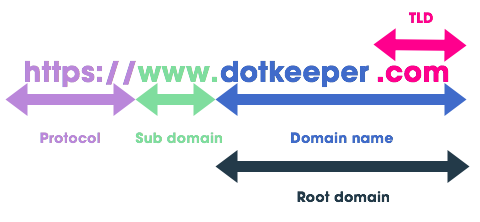
Is it time for a new website, or are you thinking about changing your domain? Exciting! This guide helps you do just that, while at the same time showing you ways to improve your chances of success on Google.
Bringing traffic to your website is a crucial task for any company with an online presence. Google is obviously a key pathway for visitors of all ages to find your websites, so it’s clear that it should be part of your marketing strategy. The techniques for improving visibility on Google are known as search engine optimisation (SEO), and a website’s domain plays a crucial role.
What to think about when you choose a domain.
To make our advice as comprehensive and readable as possible, we have broken down domains into their components. All parts of a domain, to a greater or lesser extent, can be used to optimise your web presence so let’s take a look at what you should consider and why.
*Strictly speaking a protocol is not a part of a domain, but since people generally deal with them at the same time we’ve presented some advice on that too. You’re welcome!

Top-level domains (TLDs)
Top-level domains have been a hot topic since 2014 when a host of new generic top-level domains were released. However, they’ve actually been a subject for discussion since long before then, at least for markets in Europe where .com has not been as dominant.
Generic top-level domains (gTLDs)
Google’s parent company Alphabet were one of the first to jump on the generic TLD bandwagon when they chose the address abc.xyz. Equally significantly, we choose the .wedding TLD for our wedding website. If two trend-setting actors (seriously!) choose generic TLDs, that has to mean something, right?
In all probability, gTLDs have a bright future ahead of them, especially those that reveal or hint at what visitors can expect from the website; spotify.support, mcdonalds.berlin, honda.motorcycles, and so on. At the moment though, users seem uncomfortable choosing them because of uncertainty about their effectiveness in search engines.
SEO-recommendation: If you have a genuinely global website, or if you want to build a campaign site that has a little edge, then a generic TLD might be worth considering. From a purely SEO-perspective, it has little to no effect. It has been shown, though, that a well chosen gTLD can have a positive effect on Google Ads (link in Swedish).
Country code top-level domains for local websites
In Swedish and European markets, TLDs have been debated for a long time – especially in relation to websites that are aimed at the international marketplace – but let’s not get ahead of ourselves.
For a website aimed at the Swedish market – and only the Swedish market – there are two potential alternatives; .se and .com, and both alternatives have a good chance of ranking well in Swedish Google.
SEO Recommendation: Country code top-level domains (ccTLDs, for example .se or .dk) give a local emphasis which is often appreciated by visitors. In addition, Google automatically registers, for example, .se as Swedish. This can be helpful – a .com address will need to have its settings adjusted in the Google Search Console for it to be recognised as a Swedish site.
Country code TLDs for international websites
For a website aimed at several different markets, the approach will be a little different. The recommendations above are fine for local websites; .se for Sweden, .dk for Denmark, and so on. Difficulties can arise, however, if you try to expand into a new market where your desired domain is already registered or where there is a legal barrier to registration. Take the Swedish company Thule as an example. They registered thule.se as their Swedish website, but aren’t able to use thule.dk because it’s owned by a Danish private individual and is therefore unavailable.
In such a situation, it can be worth adopting the same strategy that Thule used (it’s also a tactic favoured by their fellow Swedes IKEA). They set up .com/se as the TLD for Sweden and .com/dk for Denmark. The thule.se website now redirects to the .com/se domain. This approach is simple to set-up, manage and scale-up. A .com/se domain can be designated as Swedish using the Google Search Console – effectively becoming equivalent to a .se domain.
SEO Recommendation: The big differences between TLDs such as .dk and .se and more common ones like .com are;
- Scalability. If you can register all the country specific domains that are relevant to your organisation, then ccTLDs might be the way to go. If not, a .com domain is simpler and more comprehensive.
- Domain strength. Different versions of a .com domain (such as .com/se or .com/dk) are regarded as being a single domain, whereas domains that end with .se and .dk, are always regarded as being independent of each other. This can have a significant impact on domain authority, which we cover below.
- Targeting. For .com domains, the settings on Google Search Console need to be adjusted for a website to be associated with a specific country. With a ccTLD, the connection between the domain and its targeted country is clear and requires no adjustments.
Domain name
Choosing a domain name must be a no-brainer, right? Write down your company name when you make the application, and don’t waste any more time thinking about it. Sadly not. There’s a lot of things to consider when choosing a domain name. Google’s ranking algorithm puts a lot of weight in the text of a domain, so you should try to use your domain name to your advantage. The weighting is so significant that domain names have been used and exploited all over the world as an SEO strategy.
Exact match domains
Having a domain that exactly matches the company name is often not an option, although variants are often possible and can work well. This is mostly a tactic used by smaller, more niche websites that are built up for occasional purposes. As a demonstration, try to search for “hitta julklappar” (that means “find Christmas presents” in Swedish.)
Google themselves say that exact match domains (also known as EMDs) are not a ranking factor. This indeed appears to be the case in English-speaking markets, but in Sweden they continue to flourish.
SEO Recommendation: Proceed with caution. Perhaps a campaign or an extra website can be tested with a keyword-targeted domain, but don’t play roulette with your primary website.
There can also be good reason to choose a domain name (and a company name) that is totally unique. When you combine SEO with offline marketing, or when you build up strong brand awareness and have customers searching for your company name, you really don’t want to share Google space with anyone else.
Partial Match Domains
A tactic with similar strengths to the one above, partial match domains can be effective if used correctly. As a hypothetical, imagine that Anderssons cycle shop intend to launch their website. The owner could take one of the following domains;
- anderssons.se – a short and simple, but bland domain.
- anderssonscykelhandel.se – more concrete and exact, but a little long and overly detailed.
- anderssonscykel.se – easy to remember and includes the word ‘cykel’ – this could improve its ranking in cycle-related searches.
SEO Recommendation: If possible and relevant, it’s a good idea to include a word or phrase in the domain that potential customers search for online.
Root domain
If we merge the TLD and the domain name we get what is called the root domain. This is of particular interest for search engines and SEO enthusiasts. It is the root domain that is central to the all-important domain authority.
What is domain authority
External links to your website strengthen its domain authority, which plays a crucial part in deciding where it will rank on Google. In terms of their search engine ranking, all pages on a website benefit from a strong domain, that is, one with a high domain authority.
When a website is launched, or moves from one domain to another, its domain authority always begins at 0 and must be built up through links from other websites. Websites with a high domain authority are more powerful in this regard, and links from them will have a larger impact.
SEO Recommendation: If you already have a website, think carefully before you change domains. A lot of work is required to build up domain authority, whereas a domain that has been around for a long time will likely have been able to build up its strength over a number of years.
The same thing applies to country specific domains. By using a .com/ domain for international sites they can benefit from each other and push up the overall domain authority. Country specific TLDs however, will always be recognised as unique root domains in Google’s eyes. As a result, the domain authority of each country specific site will have to be built up independently.
Subdomains
The abbreviation www stands for world wide web. Since the internet’s foundation, www has been used as the subdomain that confirms to visitors that they are indeed on the world wide web. Today its role is more or less played out, in truth. It’s increasingly common nowadays to miss out the subdomain completely (as Dotkeeper do, for example).
Although there can be benefits to getting creative with subdomains, it doesn’t have much consequence for SEO. One consideration is that the www prefix might be firmly established with your visitors, especially if they’re of an older generation, and they may have trouble finding your site if they’re accustomed to typing in website addresses with www.
SEO Recommendation: Choose either to have the subdomain www or not. Then make sure to set up redirects to the chosen variant.
Protocol
Even if (strictly speaking) it isn’t a part of the domain, the protocol plays an important role in SEO, and choosing a domain normally goes hand-in-hand with selecting a protocol. Google has publicly stated that users of the https protocol are preferred in their rankings.
To use https, there must be an SSL certificate on the server to encrypt the data between users’ computers and the website. The certificate is an annual application that must be paid for but when that’s done, the rest takes care of itself. Nice, huh?!
SEO Recommendations: No website today should be without an SSL certificate, and when you have it in place make sure that your site redirects from http to https. Make sure that all pictures and files on the website use the https protocol.
Change rarely …but do it properly
If you already have a website, but weren’t able to follow the advice above when you initially set it up… is it worth changing now? Doubtful. Successfully changing a domain is not an easy task, so make sure you follow our advice from the beginning of your project and get help from the experts. That way, you’ll get it right from the start and you won’t have to make significant changes further down the line. Good luck!
About Linus Larsson:
Linus Larsson is not just Agency Director at Web Guide Partner (WGP), one of Sweden’s most coveted digital agencies – he is also something of a Swiss army knife. As SEO expert he has built up a breadth of competencies in many aspects of the digital world such as programming, design, and sales – a versatility he himself regards as the foundation of a successful digital marketing strategy. With many years experience in different areas of web strategy and production, he has both delivered projects to customers and shared his knowledge with industry colleagues.
Web Guide Partner is one of Sweden’s leading digital performance agencies with 30 consultants in Malmö and Stockholm. As a Google Marketing Platform Partner we help large companies across the whole of Sweden as strategic partners that provide a helicopter perspective of online presence.



